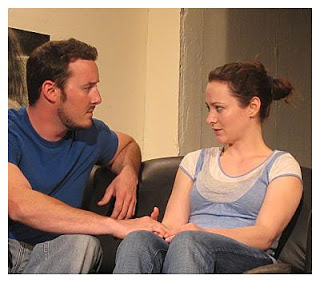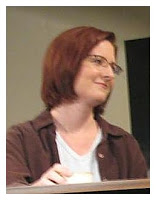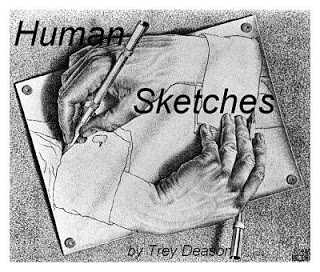Review: Human Sketches by Sam Bass Community Theatre
by Michael Meigs
This is a "world premiere," in public-relations-speak, and the folks at the Sam Bass Community Theatre once again show their inventiveness and their determination to be more than a simple source of weekend amusement for the suburbs of Austin.
SBCT isn't a large group and they don't have the ample venues or resources of some other out-of-Austin theatres. But they make up for that in pluckiness. Following close on their accomplished production of funnyman Steve Martin's quasi-absurdist piece Picasso at the Lapin Agile, they're now doing Human Sketches. The script was chosen from more than twenty original pieces submitted for SBCT's So You Think You're A Playwright? competition.
It's a winner in more ways than one.
Author Trey Deason's two-act piece is well crafted, peopled with sharply drawn central characters and examines serious, interesting issues -- although perhaps not those you might expect from the M.C. Escher sketch used on the poster.
Rebecca Guare is a young single mother who shares quarters with college student Patrick Stivik. It's convenient for both -- like any young
 parents, they both work hard, trading off caretaking for 3-year-old Michael, fitting intimacy and grown-up talk into the few hours available from their split shifts. She works as a waitress at an all-night diner; he has classes during the day, and in Act I he spends a fair amount of time clutching a thick sociology text that he doesn't get time to study.
parents, they both work hard, trading off caretaking for 3-year-old Michael, fitting intimacy and grown-up talk into the few hours available from their split shifts. She works as a waitress at an all-night diner; he has classes during the day, and in Act I he spends a fair amount of time clutching a thick sociology text that he doesn't get time to study.
Rebecca (played by River Gareth) coaxes Patrick into taking a digital picture of her. She eventually confesses that she's applying for assignments as an artist's model, even though she's a bit squeamish about the question Are you willing to pose nude? Though she answers "yes" and Patrick (played by Jeremy Barta) doesn't object, she is holding a great big mental reservation on that issue and hoping that it will never come up.
And why make this application? It turns out that she let slip to her parents that she was living with Patrick. They cut off the monthly checks that were paying her share of the living expenses there in New York City. Crises in succeeding scenes raise the importance of that modeling application.

A shift of scene brings us to the studio of artist Leticia Martindale, an assertive, no-nonsense woman who shares her life with her deaf-mute lover Julie and plans a grand finale exhibition of her paintings with help from snippy museum staffer Margot Edison, formerly her student. Leticia (Beth Burroughs, left) has exhausted the list of available artists' models, and she is looking for just the right face and unclothed figure for the painting "rebirth," intended for the centerpiece of the exhibition.
Rebecca, now styling herself Rebecca Del Guare instead of just Guare, gets the call, of course, and arrives to find herself in a world quite different from her own. It's almost more than she can handle, and her reluctance to disrobe is certainly more than artist Leticia wants to put up with. There, in the artist's studio, come challenges, gradual revelations and a completely unforeshadowed catharsis.
The second act follows the consequences of the melding of these two worlds. Deason explores the urge and ability to make art, artists both selfish and selfless, loss, and the rebirth of hope and self confidence. The figure of deaf mute Julie, played by Shauna Danos, transforms in the course of the play -- from a childlike, cheerfully gesturing walk-on in the first act to a figure of arresting stature and deep emotion. Her lengthy solo lament late in Act II is a remarkable event -- she expresses her passion and fervor entirely in mime and American sign language, with voice interpretation provided from a discreet upstage corner by museum staffer Margot .
This is a play about women. River Gareth as Rebecca is fragile, impressed and intimidated by the art world. She learns and grows over the span of the action. Margot Edison from the museum (Amy Lewis) reveals the great frustrations that have prompted her to be so sharp-tongued. Beth Burroughs as Leticia the artist, facing decline and mortality, makes that central character self-certain and unsentimental, but a creature more of air and fire than of earth.
Jeremy Barta plays a solid, comforting male figure throughout, but the text does not provide a convincing back story for him. We don't really know how or why he and Rebecca became room mates. Their apparently relaxed attitude about sex in their relationship misleads us, probably intentionally, and masks deep trauma in Rebecca's past. In retrospect, the writer really should have given us more, both about them as a couple and about the formation of Patrick's good character. Perhaps he could have amplified Patrick's uneasy remark, "Everybody has made a mistake." Without those elements, the dispute between Rebecca and Patrick in Act II lacks impact, because we have trouble believing that discussion of that event and those themes has been entirely avoided without harm for years.
New York City as a setting sets a high barrier for the story and for the cast. The piece could have been set virtually anywhere, particularly considering that it was to be produced here. For example, Amy Lewis does a fine, sharp and occasionally funny job as the harpy from the museum and, as always, she is vivid and very watchable onstage. But a real New Yorker would have had different body language, accent and subtexts as she ripped the faces off her interlocutors. As for New York as a setting -- five hundred dollars a month from the parents wouldn't have helped pay for much more than a parking space in the greater New York City area. And the Museum of Modern Art would probably not put up with any artist, however major, who had painter's block concerning the centerpiece of an imminently scheduled major exhibit.
These concerns are minor, and I confess that they represent my own impudent taking of the privilege of communicating directly with playwright Trey Deason about this substantial, very entertaining and thoughtful piece of work. Thanks to director Sean Hunter for selecting Deason's script from the two finalists and for keeping it lively.
To the company and staff at the SBCT: Thank you all. Keep it up. I look forward to my next visit to the Old Depot on Lee Street in Round Rock.
Comments posted April 1 by David Dunlap on his blog David in Austin
Hits as of 2015 03 01: 3411
Human Sketches
by Trey Deason
Sam Bass Theatre Association
